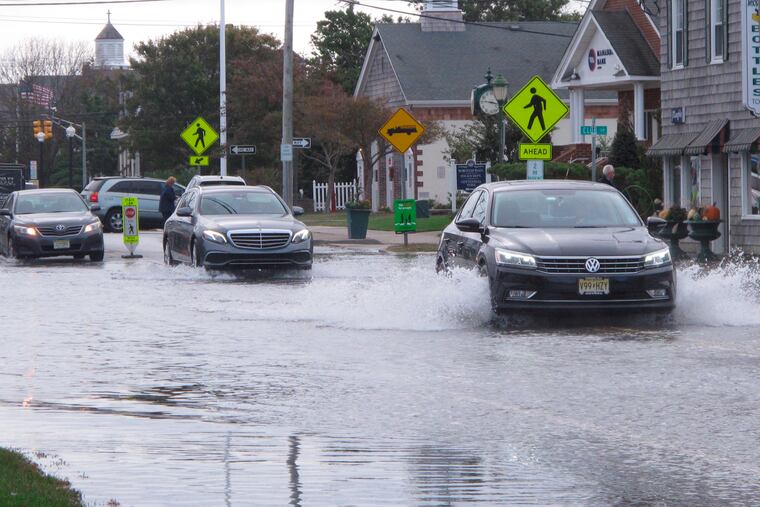Philly, A.C. to see at least 5 times more ‘sunny day’ flooding in future due to sea rise
Philly saw 8 days of flooding from just high tides — not storm surge — in 2021 in what’s known as “sunny day flooding.” NOAA projects it will see 40 to 65 days of sunny day flooding by 2050.

The Northeast is one of the nation’s areas most affected by sea-level rise, seeing twice as many days of high-tide flooding as compared with 2000, according to a new report from the National Oceanic and Atmospheric Administration.
Philadelphia and Atlantic City are no exception:
Philly saw eight days of flooding from just high tides — not storms — in 2021 in what’s known as “sunny day flooding.” It saw three days in 2000. NOAA projects the city will experience 40 to 65 days by 2050.
Atlantic City saw 13 days last year of sunny day flooding. It averaged five in 2000. Projections call for a rise to 75 to 110 days by 2050.
It’s easy to understand why the Jersey Shore experiences more flooding because of sea-level rise. But Philly is also a coastal city flanked by the Delaware River, an estuary that starts in Cape May and rises and drops with the tides all the way to Trenton.
“The tide is sneaky,” William Sweet, a NOAA oceanographer, said during a news briefing Tuesday on the state of high-tide flooding in the United States. “The tide has increased and gotten higher. So sea-level rise will also show its face in these areas like Philadelphia and Washington.”
Sea-level rise is in part attributed to warming caused by the burning of fossil fuels as ice on land melts and warmer water expands, so environmentalists were ecstatic last week over the Inflation Reduction Act, a compromise bill reached July 27 by Sens. Chuck Schumer (D., N.Y.) and Joe Manchin (D., W.Va.).
The bill would invest $369 billion to fight climate change. It includes tax rebates and credits to lower household energy costs. It contains provisions to foster research and production of wind turbines, solar panels, and batteries. It would provide incentives to buy electric vehicles.
Other tax credits are aimed at reducing carbon emissions and lessening the impact of agriculture. Senate Democrats estimate that it would reduce carbon emissions by roughly 40% by 2030.
Scientists say big measures are needed to reduce greenhouse gases that help cause warming that ultimately produces more flooding.
High-tide flooding, a symptom of climate change, is also referred to as “king” or “nuisance” tides and is becoming increasingly common, according to NOAA. High-tide flooding refers to an overflow of seawater at high tide that covers low-lying areas. It typically occurs when tides reach between 1.75 to 2 feet above the daily average high tide. The tides then spill into streets or percolate up from storm drains.
“As sea level rise continues, damaging floods that happened decades ago only during a storm now happen more regularly, like during a full-moon or with a change in prevailing winds or currents,” according to NOAA.
Sea-level rise worsens storm surge because the water starts at a higher base level. Surges occur when water rises above a normal level and gets pushed inland by wind.
Already in 2022, Reedy Point, Del., has seen a record six high-tide flooding days and one more than last year.
By 2050, high-tide flooding in the United States is expected to average 45 to 70 days, based on projections using expected relative sea-level rise. Relative sea-level rise takes into account sinking of land known as subsidence. Subsidence, which can be natural or caused by human withdrawal of drinking water, magnifies the effects of sea-level rise.
Sweet said flooding has been stable the last two years because of a now weakening La Niña, which has the effect of lowering sea levels, and because the moon has wobbled away from the Earth, lessening gravitational pull.
Both phenomena will reverse in coming years with an El Niño expected in fall, and the moon wobbling back, resulting in the resumption of a steady march of higher tides Sweet called the “steady creep of sea-level rise.”
Despite forces now holding flooding at bay, Sweet said, U.S. communities still saw an average of four days of high-tide flooding in 2021, just shy of the record of five days.
And for U.S. coastal locations, he said, “the number of high-tide flooding days is growing.”
Sweet said an additional sea-level rise of about two feet is expected over the next 30 years. NOAA says people can expect that the resulting higher tides will mean the effects of tropical storms will be more severe.